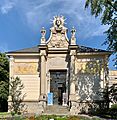Young Poland facts for kids
Young Poland (in Polish: Młoda Polska) was an important time for Polish art, writing, and music. It lasted from around 1890 until 1918. During this period, artists and writers wanted to try new, modern ways of expressing themselves.
This movement was a reaction against older ideas called positivism, which focused mainly on science and facts. Young Poland embraced new styles like decadence (a feeling that society was declining), neoromanticism (new romantic ideas), symbolism (using symbols to represent ideas), impressionism (focusing on feelings and light), and Art Nouveau (a decorative art style).
Contents
History of Young Poland
The name "Young Poland" became popular after a public statement, called a manifesto, was written by Artur Górski. This manifesto was printed in a newspaper called Życie ("Life") in Kraków in 1898.
The name quickly spread across all parts of Poland, which was divided at the time. It was similar to other art movements in Europe, like Young Germany or Young Belgium.
Literature in Young Poland
Polish writers during the Young Poland period explored two main ideas:
- The first idea showed how artists felt disappointed with the middle class and their way of life. These artists believed that culture was ending. They also saw a conflict between people and their civilization. For them, art was the most important thing, following the idea of ars gratia artis (Latin for "art for art's sake"). Some writers who explored these ideas were Kazimierz Przerwa Tetmajer and Stanisław Przybyszewski.
- The second idea continued the spirit of romanticism, so it's called neoromanticism. Writers in this group were not as organized. They wrote about many different topics. For example, Stefan Żeromski wrote about the special role of Poles. Władysław Reymont and Gabriela Zapolska wrote about social inequality, where some people have much more than others. Stanisław Wyspiański wrote about Polish history and criticized Polish society.
Other important writers from this time included:
- Wacław Berent
- Jan Kasprowicz
- Antoni Lange
- Bolesław Leśmian
- Leopold Staff
- Tadeusz Boy-Żeleński
Music in Young Poland
In music, "Young Poland" refers to a group of composers. These included Karol Szymanowski, Grzegorz Fitelberg, Ludomir Różycki, and probably Mieczysław Karłowicz.
This group was greatly influenced by new romantic music, especially from composers like Richard Strauss and Richard Wagner. They also had strong connections with "The Five", a group of Russian composers like Modest Mussorgsky and Nikolai Rimsky-Korsakov.
Art in Young Poland
During the Young Poland period, Polish art did not have one single big style. Painters and sculptors tried to continue romantic traditions while also bringing in new ways of expression popular in other countries.
The most important style was Art Nouveau, known for its flowing lines and natural forms. Polish artists also tried to create new forms of a national style. Both sculpture and painting from this time were strongly influenced by symbolism, where artists used symbols to represent deeper meanings.
Main Artists of the Period
- Olga Boznańska
- Xawery Dunikowski
- Julian Fałat
- Jacek Malczewski
- Józef Mehoffer
- Józef Pankiewicz
- Ferdynand Ruszczyc
- Jan Stanisławski
- Wojciech Weiss
- Leon Wyczółkowski
- Stanisław Wyspiański
Images for kids
-
Palace of Art, also known as "Secession" headquarters of the Kraków Society of Friends of Fine Arts, in Krakow Old Town
-
Stanisław Wyspiański self-portrait in soft pastel, 1902
See also
 In Spanish: Joven Polonia para niños
In Spanish: Joven Polonia para niños





